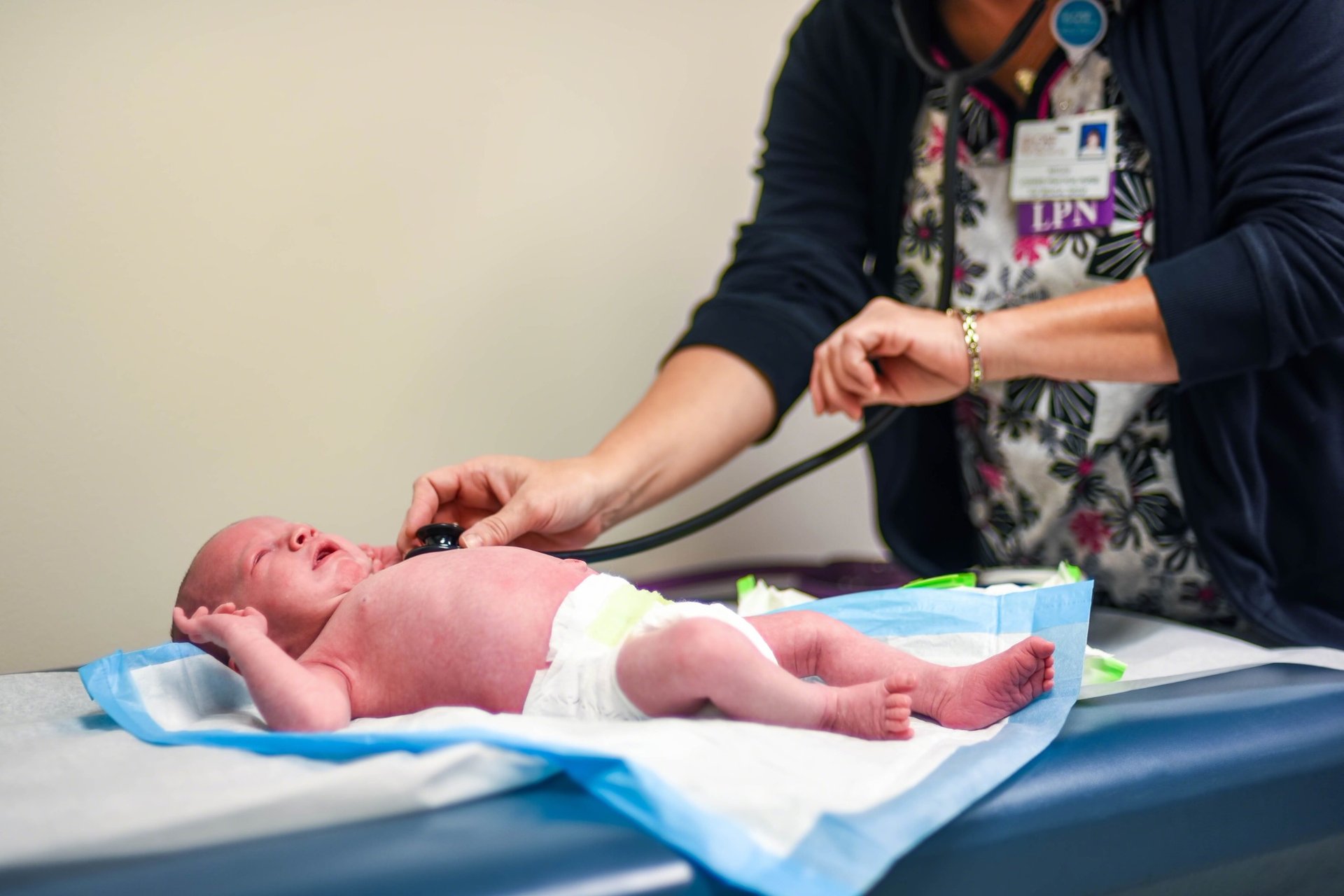
Discovering your newborn has respiratory acidosis can be terrifying. This dangerous condition occurs when carbon dioxide builds up in your baby’s bloodstream, causing their blood pH to decrease below the normal range of 7.35.
If hospital staff failed to properly monitor your neonate for breathing difficulties or delayed treatment, your child may have suffered preventable brain damage. The consequences of untreated respiratory acidosis may lead to lifelong disabilities, extensive medical bills, and heartbreaking challenges for your family.
Our birth injury attorneys understand what you’re going through. With a proven track record of securing justice for families affected by medical negligence during childbirth, we can help determine if medical malpractice contributed to your child’s condition.
If your child suffered from respiratory acidosis during birth, our Baltimore birth asphyxia attorney can help you understand your legal options and fight for the compensation your family deserves.
Our experience with cases involving respiratory acidosis in infants
At Frank Spector Law, we’ve successfully represented many families whose infants suffered respiratory acidosis due to medical negligence. Our case results include a $2.5 million settlement for a baby injured at birth in Washington, DC, and a $1.5 million jury verdict in Baltimore City for a child with an Erb’s Palsy birth injury.
In our experience with these types of cases, we’ve identified several common patterns of negligence:
- Mishandled meconium aspiration leading to airway obstruction
- Delayed delivery despite clear signs of fetal distress
- Improper ventilation techniques causing abnormally high or low CO₂ levels
✔️ Our dedicated team thoroughly investigates each case, working with medical experts to assess whether proper standards of care were followed during your child’s birth.
What is respiratory acidosis in newborns?
Respiratory acidosis occurs when a newborn’s lungs cannot effectively eliminate carbon dioxide, causing it to accumulate in the bloodstream. This excess carbon dioxide reacts with water in the blood to produce carbonic acid, resulting in a decrease in pH and creating an acidic environment.
In some cases, respiratory acidosis may occur on its own, or it may be part of a broader condition known as fetal acidemia, which refers to increased acidity in the baby’s blood caused by respiratory or metabolic factors. Unlike metabolic acidosis, which stems from metabolic processes, respiratory acidosis originates from inadequate breathing or lung function.
This condition may occur during or immediately after birth and can yield serious complications if not promptly addressed.
💡 According to the National Library of Medicine, respiratory acidosis in neonates is diagnosed when arterial blood gas analysis reveals a pH less than 7.35, accompanied by an elevated partial pressure of carbon dioxide (PaCO₂), typically exceeding 45 mmHg.

What causes high CO₂ levels in infants?
When a newborn has difficulty removing carbon dioxide from the body, it leads to respiratory acidosis, a condition where rising CO₂ lowers blood pH and disrupts normal cellular function.
This buildup, known as hypercapnia, can occur for several preventable or treatable reasons:
- Underdeveloped lungs in premature infants that cannot fully ventilate or excrete CO₂
- Meconium aspiration syndrome blocking the airways and reducing oxygen exchange
- Structural abnormalities or airway blockages impairing normal breathing
- Weak or absent respiratory effort due to neurological complications or sedative exposure
- Maternal medications that depress the baby’s respiratory drive after birth
- Delayed or improper resuscitation efforts in the delivery room
Hospitals are responsible for monitoring carbon dioxide levels in newborns using cord blood gas testing or NICU blood work. When this testing is delayed—or not done at all—it may signal inadequate care during a critical window.
What are the dangers of low CO₂ levels in infants?
While this article focuses primarily on high CO₂ levels and acidosis, it’s important to understand that low CO₂ levels (hypocapnia) present their own significant risks.
- Respiratory alkalosis may occur when a baby is overventilated, causing too rapid removal of carbon dioxide
- Reduced cerebral blood flow can result from constricted blood vessels, potentially leading to brain damage
- Calcium ion imbalances may develop, affecting cardiac function and circulation
- Oxygen saturation paradoxically decreases due to the principle known as the Bohr effect
- Cellular metabolism may be adversely affected, impairing tissue oxygenation at the cellular level
Too low or too high; both extremes require careful monitoring and management to prevent serious complications in a newborn’s fragile system.
If your baby suffered birth injuries due to improper management of acidosis, contact our birth injury lawyer in Baltimore for a free consultation today.
Fetal respiratory acidosis: What it means before birth
Fetal respiratory acidosis occurs when carbon dioxide builds up in the fetus’s blood due to impaired gas exchange, often from placental insufficiency or umbilical cord compression. This condition is identified by elevated pCO₂ levels, low pH, and a normal base deficit in cord blood analysis.
While typically considered less damaging than fetal acidosis of metabolic origin, fetal respiratory acidosis is still a critical sign of fetal distress. It suggests that the baby may have struggled to eliminate carbon dioxide in the womb, a warning that immediate intervention may have been needed.
Cord gas results showing high pCO₂ with low pH but normal base deficit help distinguish respiratory acidosis from metabolic causes, and can offer vital insight into what went wrong during labor.
⚖️ In some birth injury cases, fetal monitor tracings clearly showed signs of distress, but no action was taken until it was too late. When doctors fail to respond to early indicators of respiratory acidosis, the resulting delays in care may lead to preventable brain injury or other long-term harm.
Respiratory acidosis vs metabolic acidosis in newborns
Understanding the difference between respiratory and metabolic acidosis helps clarify both the medical urgency of your newborn’s condition and whether delays in care may support a birth injury claim.
| Type | Cause | Duration | Reversibility | Legal Relevance |
|---|---|---|---|---|
| Respiratory | CO₂ buildup from poor breathing | Immediate | Often treatable | Missed resuscitation = red flag |
| Metabolic | Hypoxia leading to acid byproducts like lactic acid | Gradual | More severe | Strong evidence of birth asphyxia or delayed delivery |
| Mixed | Both respiratory and metabolic components | Variable | Complex | May indicate prolonged distress with inadequate intervention |
| Compensated | Body attempting to buffer acid-base imbalance | Extended | Partially mitigated | Shows chronic rather than acute problems |
Understanding the difference between fetal metabolic acidosis vs respiratory acidosis is especially important when evaluating whether a birth injury was preventable.
💡 Only metabolic acidemia is directly linked to long-term neurologic injury, but when respiratory acidosis goes untreated, it can evolve into a more serious metabolic condition, raising the stakes for both health outcomes and legal accountability.

How is respiratory acidosis in newborns diagnosed?
Proper diagnosis of respiratory acidosis requires prompt and accurate assessment through multiple clinical methods.
- Cord blood gas analysis measuring pH and pCO₂ levels (normal arterial pH: 7.35-7.45; normal pCO₂: 35-45 mmHg)
- Low Apgar scores, particularly in the categories of respiratory effort and color
- Clinical signs including poor muscle tone, decreased responsiveness, and inadequate breathing
- NICU blood gas tests (ABG) to monitor ongoing acid-base status and effectiveness of treatment
- Imaging studies to rule out underlying lung disease, structural issues, or other conditions that may produce respiratory compromise
How do doctors treat respiratory acidosis in newborns?
Effective treatment of neonatal respiratory acidosis focuses on improving ventilation and addressing the underlying causes of carbon dioxide retention. Medical teams should quickly intervene to normalize the baby’s acid-base balance.
Supplemental oxygen should be administered immediately if saturation levels are low. This helps ensure adequate oxygenation while addressing the ventilation issues.
Positive pressure ventilation may be necessary to help expand the lungs and improve gas exchange. For severe cases, mechanical ventilation through intubation provides controlled support for infants unable to maintain adequate tidal volume.
NICU monitoring allows for continuous assessment of the baby’s respiratory status and adjustment of treatments. This includes regular blood gas analysis to calculate pH, pCO₂, and bicarbonate levels.
Identifying and treating underlying causes, such as infection, meconium aspiration, or congenital abnormalities, is essential for long-term recovery.
⚠️ Delayed or improper ventilation during this critical window can turn a treatable condition into lifelong injury; we’ve seen this pattern in many cases.
What happens if respiratory acidosis isn’t treated properly?
When respiratory acidosis goes untreated or is managed inadequately, the consequences can be severe and potentially life-altering for your child.
- Progression to metabolic acidosis as the body’s compensatory mechanisms become overwhelmed, often triggered by a lack of oxygen at birth that leads to acid buildup and cellular damage
- Hypoxic-Ischemic Encephalopathy (HIE) resulting from inadequate oxygen delivery to the brain, potentially causing damage to the central nervous system
- Seizures occurring as neurons in the brain respond abnormally to the acidic environment and oxygen deprivation
- Permanent brain damage affecting cognitive development, motor skills, and other neurological functions
- Long-term developmental delays or, in the most severe cases, death from profound physiological stress on vital organs
⚖️ According to the Centers for Disease Control and Prevention (CDC), birth injuries related to oxygen deprivation and acidosis are often preventable with proper monitoring and timely intervention.
If you believe your child’s injuries resulted from medical negligence, our Maryland birth injury attorney can help you pursue justice and compensation for your family.
Hypothetical scenarios relating to newborn respiratory acidosis
💡 Hypothetical Scenario #1:
A term infant delivered after prolonged labor shows low Apgar scores and labored breathing. Despite these warning signs, the medical team delays intubation and blood gas testing for over an hour. When finally assessed, the baby’s pH is 7.18 with pCO₂ of 65 mmHg, indicating severe respiratory acidosis.
By this point, the infant has developed seizures and requires transfer to a specialty NICU. Later testing reveals permanent brain damage that could have been minimized with prompt intervention.
💡 Hypothetical Scenario #2:
During labor, fetal monitoring shows variable decelerations suggesting possible cord compression. The obstetrician decides to continue labor rather than perform an emergency cesarean section. Upon delivery, the infant appears blue with poor respiratory effort.
Cord blood gas analysis shows respiratory acidosis with a pH of 7.22 and elevated pCO₂. The NICU team quickly implements positive pressure ventilation and closely monitors blood gases. Thanks to this rapid intervention, the acidosis is reversed within hours, and the baby recovers without long-term complications.
These scenarios highlight just how quickly respiratory acidosis can escalate, and how much difference timely intervention can make. If your child experienced labored breathing after birth, delayed resuscitation, or was later diagnosed with brain damage, it’s worth asking whether medical providers responded appropriately.
Our birth injury attorneys can help you review your child’s medical records and determine whether medical negligence played a role in the outcome.
Can respiratory acidosis in newborns be a sign of medical malpractice?
Not every case of neonatal respiratory acidosis is the result of malpractice. However, certain warning signs may point to a failure to meet accepted standards of care during labor, delivery, or immediate postnatal care.
- Failure to monitor CO₂ levels or perform timely blood gas analysis may prevent early detection and life-saving intervention. These are basic, expected standards in any at-risk birth.
- Delayed intubation or inadequate NICU respiratory support can allow a manageable condition to progress into permanent injury. Providers must act quickly when newborns show signs of respiratory distress.
- Missing or incomplete fetal heart monitoring strips may suggest that warning signs of fetal distress were not properly tracked during labor.
- No documentation of Apgar scores or oxygen interventions could indicate lapses in post-delivery assessment, key tools in identifying and treating respiratory acidosis early.
📌 If medical professionals failed to recognize or respond to signs of respiratory acidosis in your newborn, it may be worth having the case reviewed. Our team at Frank Spector Law understands the complex medical standards involved and how to uncover when they were breached.
Call 443-845-1456 or contact us through our online form for a free consultation. We’ll help you understand whether malpractice may have played a role in your child’s injury.

FAQs
Can a baby recover from respiratory acidosis?
Many infants can fully recover from respiratory acidosis when it’s promptly identified and treated. The prognosis depends on several factors, including the severity and duration of the acidosis, how quickly treatment was initiated, and whether the condition progressed to affect other body systems or cause hypoxia.
How do I know if malpractice played a role?
Determining if malpractice contributed to your child’s respiratory acidosis requires expert review of medical records. Warning signs include missing documentation, failure to respond to abnormal test results, delays in necessary interventions, or deviation from standard protocols for managing neonatal respiratory distress.
What’s the difference between fetal and neonatal respiratory acidosis?
Fetal respiratory acidosis occurs before birth when the fetus cannot eliminate carbon dioxide properly through the placenta. Neonatal respiratory acidosis develops after birth when the newborn’s lungs cannot effectively excrete carbon dioxide. Both conditions involve similar physiological mechanisms but differ in timing and treatment approaches.
What evidence is needed to file a claim?
To file a successful medical malpractice claim, you’ll need medical records documenting the acidosis, expert testimony establishing the standard of care, evidence showing this standard was breached, and proof that the breach directly caused your child’s injuries. Our attorneys work with medical experts to build comprehensive cases.
What does a high pCO₂ level mean for my newborn?
A high pCO₂ level (above 45 mmHg) indicates your newborn is retaining too much carbon dioxide, which can combine with water to form carbonic acid in the bloodstream. This may occur due to inadequate breathing, airway issues, or ventilation problems and requires prompt medical intervention to prevent complications like intraventricular hemorrhage or stenosis of blood vessels.
